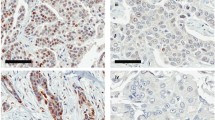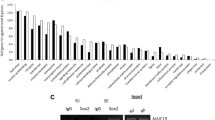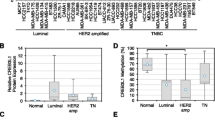Summary
CCAAT/Enhancer Binding Proteins (C/EBPs) are a highly conserved family of leucine zipper proteins that regulate cell growth and differentiation. C/EBPδ functions in the initiation and maintenance of mammary epithelial cell G0 growth arrest and ‘loss of function’ alterations in C/EBPδ gene expression have been reported in human breast cancer and in rodent carcinogen-induced mammary tumors. The molecular mechanism underlying reduced C/EBPδ gene expression in mammary tumorigenesis, however, is unknown. In this report we demonstrate that C/EBPδ gene expression is undetectable in the SUM-52PE human breast cancer cell line and that silencing of SUM-52PE C/EBPδ gene expression is due to epigenetic promoter hypermethylation (26/27 CpGs methylated). The hypermethylated SUM-52PE C/EBPδ gene promoter is associated with reduced levels of acetylated Histone H4, consistent with a closed, transcriptionally inactive chromatin conformation. Treatment with 5′-aza-cytidine and trichostatin A (TSA) re-activates cytokine-induced SUM-52PE C/EBPδ gene expression. C/EBPδ gene expression is reduced to virtually undetectable levels in 32% (18/57) of primary human breast tumors. Site-specific CpG methylation was observed in 33% (6/18) of the low C/EBPδ expressing primary breast tumors. CpG methylation adjacent to the C/EBPδ proximal promoter Sp1 site was associated with reduced C/EBPδ expression in a primary breast cancer sample. Electromobility shift assays (EMSA) demonstrated a significant reduction in binding to oligos containing the CpG methylation 5′ to the Sp1 binding site. These results demonstrate a direct link between C/EBPδ gene promoter hyper- and site specific-methylation and reduced C/EBPδ gene expression in breast cancer cell lines and primary breast tumors.
Similar content being viewed by others
Abbreviations
- C/EBP:
-
CCAAT/Enhancer Binding Protein
- DMBA:
-
7,12-dimethylbenz[a]anthracene
- JAK1, JAK2, TYK2:
-
Janus Kinases
- MSPCR:
-
Methylation specific PCR
- PhIP:
-
2-amino-1-methyl-6-phenylimidazo[4,5-b] pyridine
- STAT3:
-
signal transducer and activator of transcription3
References
Ramji DP, Foka P, 2002. CCAAT/enhancer-binding proteins: structure, function and regulation Biochem J 365:561–575
Vinson C, Myakishev M, Acharya A, Mir A, Moll J, Bonowich M, 2002. Classification of human B-ZIP proteins based on dimerization properties Mol Cell Biol 22:6321–6335
Timchenko NA, Wilde M, Darlington GJ, 1999. C/EBPα regulates formation of S-Phase-Specific E2F-p107 complexes in livers of newborn mice Mol Cell Biol 19:2936–2945
Harris TE, Albrecht JH, Nakanishi M, Darlington GJ, 2001. CCAAT/Enhancer-binding Protein-α Cooperates with p21 to Inhibit Cyclin-dependent Kinase-2 Activity and Induces Growth Arrest Independent of DNA Binding J Biol Chem 276:29200–29209
Wang H, Iakova P, Wilde M, Welm A, Goode T, Roesler WJ, Timchenko NA, 2001. C/EBPalpha arrests cell proliferation through direct inhibition of Cdk2 and Cdk4 Mol Cell 8:817–828
Slomiany BA, D’Arigo KL, Kelly MM, Kurtz DT, 2000. C/EBPα inhibits cell growth via direct repression of E2F-DP-mediated transcription Mol Cell Biol 20:5986–5997
Wang H, Goode T, Iokova P, Albrecht JH, Timchenko NA, 2002. C/EBPα triggers proteasome-dependent degradation of cdk4 during growth arrest EMBO J 21:930–941
Chien P-L, Riley DJ, Chen-Kiang S, Lee W-H, 1996. Retinoblastoma protein directly interacts with and activates the transcription factor NF-IL6 Proc Nat Acad Sci 93:465–469
D’Alo F, Johansen LM, Nelson EA, Radomska HS, Evans EK, Zhang P, Nerlov C, Tenen DG, 2003. The amino terminal and E2F interaction domains are critical for C/EBPα-mediated induction of granulopoietic development of hematopoietic cells Blood 102: 3163–3171
Gery S, Gombart AF, Fung YK, Koeffler HP, 2004. C/EBPɛ interacts with retinoblastoma and E2F1 during granulopoiesis Blood 103:828–835
Ron D, 1997. TLS-CHOP and the role of RNA-binding proteins in oncogenic transformation. In, Rauscher FJ III, Vogt PK, (eds) Chromosomal Translocations and Oncogenic Transcription factors. Springer-Verlag, Heidelberg, Germany, 131–142
DG Tenen, 2001. Abnormalities of the CEBP alpha transcription factor: a major target in acute myeloid leukemia Leukemia 15:688–689
Halmos B, Huettner CS, Kocher O, Ferenczi K, Karp DD, Tenen DG, 2002. Down-regulation and antiproliferative role of C/EBPα in lung cancer Cancer Res 62:528–534
Zahnow CA, 2002. CCAAT/Enhancer binding protein in normal mammary development and breast cancer Breast Cancer Res 4:113–121
Porter D, Krop IE, Nasser S, Sgroi D, Kaelin C, Marks JR, Riggins G, Polyak KA, 2001. SAGE (Serial Analysis of Gene Expression) view of breast tumor progression Cancer Res 61:5697–5702
Porter D, Lahti-Domenici J, Keshaviah A, Bae YK, Argani P, Marks J, Richardson A, Cooper A, Strausberg R, Riggins GJ, Schnitt S, Gabrielson E, Gelman R,Polyak K, 2003. Molecular markers in ductal carcinoma in situ of the breast Mol Cancer Res 1:362–375
Kuramoto T, Morimura K, Yamashita S, Okochi E, Watanabe N, Ohta T, Ohki M, Fukushima S, Sugimura T, Ushijima T, 2002. Etiology-specific gene expression profiles in rat mammary carcinomas Cancer Res 62:3592–3597
O’Rourke JP, Yuan R, DeWille JW, 1997. CCAAT/Enhancer binding protein-delta is induced in growth arrested mouse mammary epithelial cells J Biol Chem 272:6291–6296
O’Rourke JP, Newbound GC, Hutt JA, DeWille JW, 1999. C/EBPδ regulates mammary epithelial cell G0 growth arrest and apoptosis J Biol Chem 274:16582–16589
O’Rourke JP, Hutt JA, DeWille JW, 1999. Transcriptional regulation of the C/EBPδ in G0 growth arrested mouse mammary epithelial cells Biochem Biophys Res Comm 262: 696–701
Hutt JA, O’Rourke JP, DeWille JW, 2000. Stat3 activates C/EBPδ gene transcription in G0 growth arrested mouse mammary epithelial cells, in involuting mouse mammary gland J Biol Chem 275:29123–29131
Hutt JA, DeWille JW, 2002. Oncostatin M Induces growth arrest of mammary epithelial cells via a CCAAT/Enhancer binding protein delta dependent pathway Mol Cancer Ther 1:601–610
Sivko GS, DeWille JW, 2004. CCAAT/enhancer binding protein delta (C/EBPdelta) regulation and expression in human mammary epithelial cells: I. “Loss of function” alterations in the C/EBPdelta growth inhibitory pathway in breast cancer cell lines J Cell Biochem 93:830–843
Sivko GS, Sanford DC, Dearth LD, Tang D, DeWille JW, 2004. CCAAT/enhancer binding protein delta (C/EBPdelta) regulation and expression in human mammary epithelial cells: II. Analysis of activating signal transduction pathways, transcriptional, post-transcriptional, and post-translational control J Cell Biochem 93:844–856
Gigliotti AP, Johnson PJ, Sterneck E, DeWille JW, 2003. CCAAT/Enhancer Binding proteinδ (C/EBPδ) knockout mice exhibit increased mammary epithelial cell proliferation Exp Biol Med 228:278–285
Vegesan V, Takeuchi S, Hofmann W-K, Ikeezoe T, Tavor S, Krug U, Fermin AC, Heaney A, Miller CW, Koeffler HP, 2001. C/EBP-β, C/EBP-δ, PU.1, AML1 genes: mutational analysis in 381 samples of hematopietic and solid malignancies Leukemia Res 26:451–457
Tang D, DeWille JW, 2003. Detection of polymorphisms in the human C/EBPδ gene by single strand conformation polymorphism (SSCP) analysis Mol Cellular Probes 17:11–14
Nephew KP, TH-M Huang, 2003. Epigenetic gene silencing in cancer initiation and progression Cancer Letts 190:125–133
Widschwendter M, Jones PA, 2002. DNA methylation and breast carcinogenesis Oncogene 21:5462–5482
Zhu W-G, Srinivasan K, Dai Z, Duan W, Druhan LJ, Ding H, Yee L, Villalona-Calero A, Plass C, Otterson GA, 2003. Methylation of adjacent CpG sites affects Sp1/Sp3 binding and activity in the p21 cip1 promoter Mol Cell Biol 23:4056–4065
Ethier SP, Kokeny EK, Ridings JW, Dilts A, 1996. erbB family receptor expression and growth regulation in a newly isolated human breast cancer cell line Cancer Res 56:899–907
Cantwell CA, Sterneck E, Johnson PF, 1998. Interleukin-6-specific activation of the C/EBPdelta gene in hepatocytes is mediated by Stat3 and Sp1 Mol Cell Biol 18:2108–2117
Sanford DC, DeWille JW, 2005. C/EBPδ is a downstream mediator of IL-6 induced growth inhibition of prostate cancer cells The Prostate 63:143–154
Irvine RA, Lin IG, Hsieh C-L, 2002. DNA methylation has a local effect on transcription and histone acetylation Mol Cell Biol 22:6689–6696
Klochendler-Yeivin A, Yaniv M, 2001. Chromatin modifiers and tumor suppression Biochim et Biophys Acta 1551:M1–M10
Peterson CL, Laniel MA, 2004. Histones and histone modifications Current Biol 14:R546–551
Sherr CJ, 2004. Principles of tumor suppression Cell 116:235–246
Wood S, Schertzer M, Yaremko ML, 1995. Sequence identity locates CEBPD and FGFR1 to mapped human loci within proximal 8p Cytogenet Cell Genet 70 (3–4): 188–191
Nagaoka M, Shiraishi Y, Sugiura Y, 2001. Selected base sequence outside the target binding site of zinc finger protein Sp1 Nucl Acid Res 29:4920–4929
Arapshian A, Kuppumbatti YS, Mira-y-Lopez R, 2000. Methylation of conserved CpG sites neighboring the beta retinoic acid response element may mediate retinoic acid receptor beta gene silencing in MCF-7 breast cancer cells Oncogene 19:4066–4070
Mancini DN, Rodenhiser DI, Ainsworth PJ, O’Malley FP, Singh SM, Xing W, Archer T, 1998. CpG methylation within the 5′ regulatory region of the BRCA1 gene is tumor specific and includes a putative CREB binding site Oncogene 16:1161–1169
Mancini-DiNardo DN, Butcher DT, Robinson DP, Archer TK, Rodenhiser DI, 2001. Functional analysis of CpG methylation in the BRCA1 promoter region Oncogene 20:5331–5340
Kerangueven F, Noguchi T, Coulier F, Allione F, Wargniez V, Simony-Lafontaine J, Longy M, Jacquemier J, Sobol H, Eisinger F, Birnbaum D, 1997. Genome-wide search for loss of heterozygosity shows extensive genetic diversity of human breast carcinomas Cancer Res 57:5469–5474
Smiraglia DJ, Rush LJ, Fruhwald MC, Dai Z, Held WA, Costello JF, Lang JC, Eng C, Li B, Wright FA, Caligiuri MA, Plass C, 2001. Excessive CpG island hypermethylation in cancer cell lines versus primary malignancies Hum Mol Genet 10:1413–1419
Ueki T, Walter KM, Skinner H, Jaffee E, Hruban R, Goggins M, 2002. Aberrant CpG island methylation in cancer cell lines arises in the primary cancer from which they were derived Oncogene 21: 2114–2117
Paz MF, Fraga MF, Avila S, Guo M, Pollan M, Herman JG, Estellar MA, 2003. Systematic profile of DNA methylation in human cancer cell lines Cancer Res 63:1114–1121
Scherf U, Ross DT, Waltham M, Smith LH, Lee JK, Tanabe L, Kohn KW, Reinhold WC, Myers TG, Andrews DT, Scudiero DA, Eisen MB, Sausville EA, Pommier Y, Botsein D, Brown PO, Weinstein JN, 2000. A gene expression database for the molecular pharmacology of cancer Nature Genet 24:236–244
Grant SL, Begley CG, 1999 The Oncostatin M signaling pathway. reversing the neoplastic phenotype Mol Med Today 5:406–412
Author information
Authors and Affiliations
Corresponding author
Rights and permissions
About this article
Cite this article
Tang, D., Sivko, G. & DeWille, J. Promoter methylation reduces C/EBPδ (CEBPD) gene expression in the SUM-52PE human breast cancer cell line and in primary breast tumors. Breast Cancer Res Treat 95, 161–170 (2006). https://doi.org/10.1007/s10549-005-9061-3
Accepted:
Published:
Issue Date:
DOI: https://doi.org/10.1007/s10549-005-9061-3




